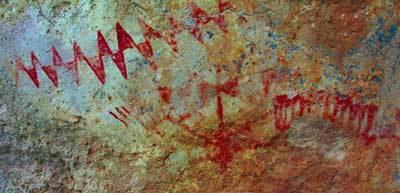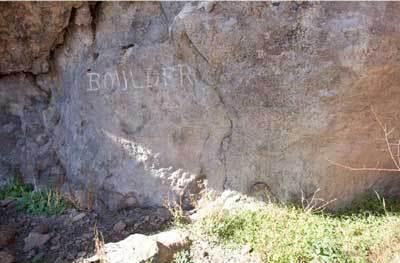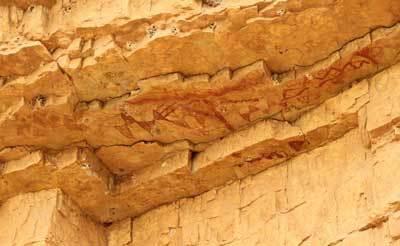Blake De Pastino
Source - http://westerndigs.org/hallucinogenic-plants-may-be-key-to-decoding-ancient-southwestern-paintings-expert-says/
Dozens of rock art sites in southern New Mexico, recently documented for the first time, are revealing unexpected botanical clues that archaeologists say may help unlock the meaning of the ancient abstract paintings.
Over a swath of the Chihuahuan Desert stretching from Carlsbad to Las Cruces, at least 24 rock art panels have been found bearing the same distinctive pictographs: repeated series of triangles painted in combinations of red, yellow, and black.

A rock art panel found at Dripping Springs, New Mexico depicts abstract triangle motifs. At this panel and others like it, potent wild tobacco was found growing beneath the image. Photograph enhanced with DStretch. (Courtesy L. Loendorf)
And at each of these sites, archaeologists have noticed similarities not just on the rock, but in the ground.
Hallucinogenic plants were found growing beneath the triangle designs, including a particularly potent species of wild tobacco and the potentially deadly psychedelic known as datura.
Researchers believe that the plants may be a kind of living artifact, left there nearly a thousand years ago by shamans who smoked the leaves of the plants in preparation for their painting.
“I think almost certainly that they’re trancing on this stuff,” said Dr. Lawrence Loendorf, president of the archaeological firm Sacred Sites Research, of the ancient artisans.
“I think there’s a real good chance that they’re using tobacco in large enough amounts that they’re going into altered states of consciousness, and I think that’s how [the hallucinogenic plants] are getting there.
“[They're] getting to those sites because they were used for special ceremonial purposes.”
The region that Loendorf and his colleagues have been exploring was once home to the Jornada Mogollon, a culture of foraging farmers similar to the early Ancestral Puebloans, who occupied the territory from about the 5th to the 15th centuries.
Among the marks the Jornadans left on the land were sophisticated and colorful pictographs, ranging from recognizable plant, animal, and human forms to more abstract patterns.
They also crafted painted pottery in signature styles of red, brown, and black, known today as El Paso phase ceramics, which vary by era and design.
Over the past three years, Loendorf and his colleagues have been studying rock art throughout the Jornadans’ range — first at Fort Bliss, then on Bureau of Land Management holdings around Carlsbad, and finally on property owned by New Mexico State University near the town of Dona Ana.

Wild tobacco found growing beneath rock art at Dripping Springs, with triangle motifs visible at right. (Courtesy L. Loendorf)
The triangle motifs first showed up at about 20 sites that the team surveyed at Fort Bliss, Loendorf said.
But it was during their second survey — of the lands around Carlsbad — that they noticed tobacco and datura growing under similar pictographs found there.
And when their work took them farther west, to record pictographs near Dona Ana in the Rio Grande valley, the team discovered the same pattern yet again, both in the rock art itself and in the plant life around it.
“What really started to drive it home was the fact that the paintings at the [Dona Ana] sites were the same thing — they were painted triangle signs, in red and black and other colors,” Loendorf said.
“So we went back and started looking at some of the sites that we’d recorded at Fort Bliss, and we looked for the sites that had painted triangles. We pulled up our photos and discovered that there was tobacco growing there that we hadn’t noticed previously.”
All of the sites that featured the triangle motifs also turned up sherds of Jornadan pottery, he noted, found in deposits that have been radiocarbon dated to around 1000 CE.
“Every one of the sites where we find the tobacco, we also find El Paso ceramics, or we find other kinds of pots … that date generally in that same range,” he said.
To help piece these clues together, Loendorf turned to the archaeological literature of southern New Mexico, and found that similar triangular patterns of rock art had previously been recorded throughout the Jornada region.
“I’ve now found a half-dozen more sites that have these painted triangles, and there’s tobacco growing right at the base of the panels, or somewhere near them.
“Thus far I’ve not found a site with painted triangle motifs that doesn’t have tobacco growing at it. Thus far, I’ve not found one.”
The key to the meaning of the triangles, as well as the hallucinogens, may be in the ethnographic record of modern native groups, particularly in northern and western Mexico, Loendorf said.
Groups ranging from the Rarámuri, also known as the Tarahumara, and the Huichol have both been known to induce visions using the same wild tobacco found at the rock-art sites, he said.
Known as coyote tobacco, the plant contains up to three times the amount of nicotine as conventional tobacco, and, if smoked continuously, “one right after the other for maybe eight hours or six hours,” it can bring about a trace-like state, he said.
While all of the 24 sites with the triangle motif were found to have tobacco growing nearby, only three featured outcrops of the more deadly datura — a plant also known to have been used, and feared, in some Southwestern cultures, Loendorf added.
“No one’s really drawn the correlation between datura and rock art sites,” he said. “We see it at a lot of rock art sites, but it grows in a lot of other places as well.

Triangle motifs were even found on this high rock overhang, at Walt’s Canyon near Carlsbad, where coyote tobacco again was found. (Courtesy L. Loendorf)
“But it can be very, very powerful, and whoever uses it has to be very careful, because you’ll die taking that stuff.”
It’s the similarities to the Huichol, however, that Loendorf suspects may best explain the significance of the triangular shapes themselves.
That’s because series of triangles, especially one triangle inverted over another to make an hourglass shape, is typically recognized as a symbol of water, and the vessels used to carry it.
“Two triangles put together represent a water gourd, and we have seen these [Huichol] pots that are put together in different ways that have these triangular designs on them,” he said.
Loendorf says that more study is needed, but the evidence gathered so far suggests that the mysterious zigzags appearing throughout southern New Mexico rock art may be thousand-year-old entreaties for life-giving rain.
“I think that probably the ultimate reason for going through this trance is to intervene with the spirits to make it rain,” he said.
In which case, the tobacco and datura were likely not planted intentionally, but rather were seeded accidentally as shamans brought the plants in for ceremonial use, leaving living reminders of the materials they used to talk with the spirits.
For now, Loendorf and his team plan to use plasma oxidation technology to date paint samples from some of the rock art, in an effort to narrow down the age and the cultural phase that created it.
“From my perspective, every time I record a rock art site, I think that I’ve just done something important, for the very fact that we’re losing them so fast. And once you get some recorded, then you can see these patterns,” he said.
“You don’t learn the patterns unless you document the sites.”